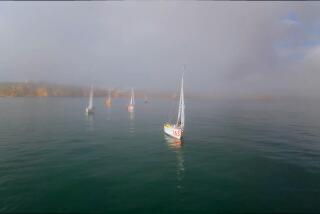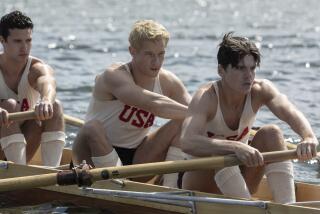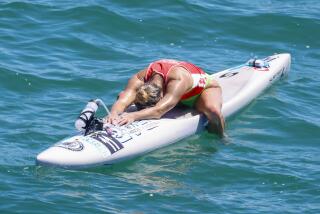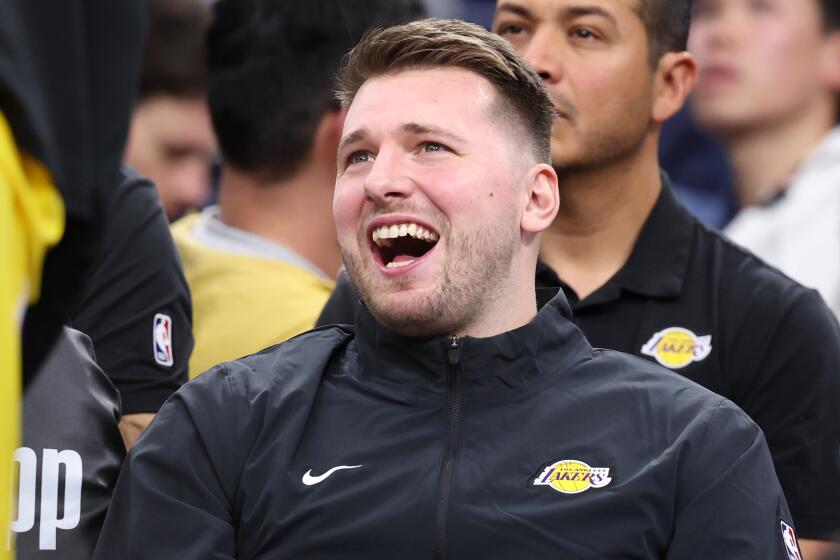Rowing Rivalry : Strong Cal State Long Beach Crew Gets in ‘Swing,’ Thrashes British Oarsmen in a Most Grueling Sport
- Share via
With the rain still beating them after the Cal State Long Beach crew already had, the Cambridge University oarsmen were slumped in their boat, gasping. Rowing 2,000 meters against the wind had left them contorted like broken dolls.
They looked more ravaged than runners at a marathon finish line, so perhaps it was true what rowers say--that their sport is the most grueling.
CSULB’s rowers also had that sensation of feeling like jelly. But winning--as it always does--had made them less aware of it. They hid their gasps and showed American flags.
“You have to compose yourself,” Rick Blazer, one of the eight men in the 49er boat, said after the race. “Some people lay back and look exhausted. That just looks bad.”
“From the very start you’re in pain,” said Roger Reynolds, one of Blazer’s teammates, “but you don’t think about it.”
It has been the 49ers’ opponents who have been suffering the most. The CSULB crew, one of the strongest on the West Coast, is undefeated in four races this season after outdistancing Cambridge and San Diego State in a ballyhooed (“The British Are Coming”) regatta Saturday at the Long Beach Marine Stadium. Other victories have been against UC San Diego, USC and the University of San Diego.
The regatta was planned as a showcase for a sport in which the number of college and club competitors in the United States has almost doubled to 17,000 in two years. The organizers also felt Long Beach was ready for international competition against a school where rowing is as renowned as football is on most American campuses.
Rowers Ignore Weather
At 10 a.m., the Kingston Trio, over loudspeakers at the stadium boathouse, sang, “It takes a worried man to sing a worried song.”
And as the rain began to fall from a decidedly British sky, Earl Johnson, one of the event organizers, worried.
“The rowers don’t care about the elements but the fans do,” said Johnson, a former CSULB rower. He was hoping that there would be enough $1 donations to provide some traveling money for the 49er crew, which gets little assistance from the university because it is a club sport.
During the preliminary races, with Cambridge still back at the Queen Mary Hotel, the 49er varsity tried to keep warm in Pete Archer’s boathouse.
A short, perky man of 83, Archer taught swimming at the nearby Colorado Lagoon in 1929. He was a longtime coach of rowing and every other sport except golf and tennis.
Archer now repairs the long, slender shells that are stacked to the ceiling, and on Sundays, when he is by himself, varnishes them.
“This and swimming are the two greatest sports,” Archer said. “I’ve always maintained that people in or on the water never have any problems like dope or roughness. Water is relaxing. I never had any problems with rowers or swimmers, but when I got to coaching football, I had problems.”
During their week’s stay in Long Beach, the Cambridge rowers had been surprised to find that the 49er rowers are not campus heroes.
“I’d predict that half the people (at CSULB) don’t know we have a rowing team,” said senior Dan Johnson, the 49er captain and Earl Johnson’s son, as the team began to stretch. But Johnson expressed no bitterness that he was a big man on campus only in size (6 feet 5, 200 pounds).
Johnson was pulled into rowing by the sport’s esoteric nature and its great conditioning value.
“This is purely a team sport,” Johnson said. “There is no glory for an individual. There are no ego problems, you compete for the love of it--you don’t see rowers on Wheaties boxes.”
Rowers are also a different breed because they willingly endure practices that start at 5:30 a.m. six days a week. They do it because the tranquility of that hour and the feeling of the boat gliding through the water are enough to offset the agony of two-hour workouts. With their 9 p.m. bedtime, they are not the most coveted athletes for campus parties and their T-shirts explain why: “I can’t . . . I have crew in the morning.”
The reward comes when the elusive split-second timing--called “swing”--among all eight rowers is achieved. “All of a sudden it happens,” Dan Johnson said. “Each oar enters the water at the same time, all eight are pulling together and the boat picks up and moves.”
There is a special camaraderie in an eights crew, which grows from each oarsman being trusted by the others not to let down.
“If one person slacks off or shifts his weight, it messes it up” for everybody else, Johnson said.
“We’re friends, we really care about each other,” Rick Blazer said.
Competition Is Intense
Competition among the 24 CSULB varsity members to win one of the eight seats is intense. “You always have your seat on the line, you’re always getting pushed,” Blazer said. “But when you make the first boat, your teammates look up to you.”
Most rowers do not take up the sport until they have reached college.
The CSULB coach, John Van Blom, said that 99% of his rowers came to college with no rowing experience. To recruit, he said, “We usually go up to the campus and look for the biggest guys and ask them if they want to row.” Power and reach during the rowing stroke are vital. A tall rower’s oar goes through the water for a longer time than a short rower’s would, resulting in more drive.
Blazer, a junior who once played basketball at Lakewood High School, said the 49ers recruit at area high schools, looking particularly for basketball players who are short only in ego and who might be willing to switch to a new sport.
Neophytes learn quickly from Van Blom, a master rower who was an Olympian in 1968, ’72 and ’76.
Wearing a tie beneath a red slicker, Van Blom was in the 6-5, 200-pound range like most of his crew members. In fact, with their well-developed muscles, the rowers were more imposing than a group of 49er football players.
The Cambridge crew arrived shortly before the big 1 p.m. race and jogged to get loose. They had some height but not the muscle of the Long Beach men. None of the 49ers, though, knew what to expect because during the week Cambridge had avoided discussing their times, and instead, Blazer said, had joked that, “We go as fast as we can and when we get tired, stop for some sherry.”
The race finally started on water that was almost black. The 49er crew, with the wind and rain stinging their bare shoulders, led from the start and pulled away. Obviously, they had “the swing.”
The banks of the channel, which had overflowed with 110,000 people for the 1932 Olympics, did not come close to having even the few thousand Earl Johnson had hoped for, but the cheers of a hardy crowd of a few hundred carried loudly across the water.
The rowers did not turn to look. “Your head weighs as much as a bowling ball, so you don’t look around,” Dan Johnson had said earlier.
The 49ers finished in 6 minutes 21 seconds. San Diego State was second and Cambridge third, about 15 seconds behind the 49ers.
“They’re just not quite as strong,” Blazer said.
The Cambridge oarsmen returned to the boathouse with their blue T-shirts soaked with sea water and sweat, and their cheeks burned a deep red by the wind which had been too much for them. They were disappointed but good losers.
“The Long Beach boys have looked after us real well,” said Robert MacLeod, the captain. “The best crew won today, I would say.”
Afterwards, an award-presentation ceremony was held on the boathouse lawn. The 49ers received the Cambridge Cup and, as each member of the two crews was introduced, he was greeted with cheers and a chanting of his name.
And on this rare moment of rowers’ glory, the sun tried hard to shine.
More to Read
Go beyond the scoreboard
Get the latest on L.A.'s teams in the daily Sports Report newsletter.
You may occasionally receive promotional content from the Los Angeles Times.










